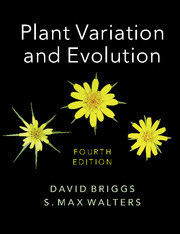Book contents
- Frontmatter
- Contents
- Preface to the Fourth Edition
- Acknowledgements
- Note on names of plants
- List of abbreviations
- 1 Investigating plant variation and evolution
- 2 From Ray to Darwin
- 3 Early work on biometry
- 4 Early work on the basis of individual variation
- 5 Post-Darwinian ideas about evolution
- 6 DNA: towards an understanding of heredity and molecular evolution
- 7 Breeding systems
- 8 Intraspecific variation and the ecotype concept
- 9 Pattern and process in plant populations
- 10 Pattern and process: factors interacting with natural selection
- 11 Populations: origins and extinctions
- 12 Species and speciation: concepts and models
- 13 Allopatric speciation and hybridisation
- 14 Abrupt speciation
- 15 The species concept
- 16 Flowering plant evolution: advances, challenges and prospects
- 17 Historical biogeography
- 18 The evolutionary impact of human activities
- 19 The taxonomic challenge ahead
- 20 Conservation: from protection to restoration and beyond
- Glossary
- References
- Index
7 - Breeding systems
Published online by Cambridge University Press: 05 June 2016
- Frontmatter
- Contents
- Preface to the Fourth Edition
- Acknowledgements
- Note on names of plants
- List of abbreviations
- 1 Investigating plant variation and evolution
- 2 From Ray to Darwin
- 3 Early work on biometry
- 4 Early work on the basis of individual variation
- 5 Post-Darwinian ideas about evolution
- 6 DNA: towards an understanding of heredity and molecular evolution
- 7 Breeding systems
- 8 Intraspecific variation and the ecotype concept
- 9 Pattern and process in plant populations
- 10 Pattern and process: factors interacting with natural selection
- 11 Populations: origins and extinctions
- 12 Species and speciation: concepts and models
- 13 Allopatric speciation and hybridisation
- 14 Abrupt speciation
- 15 The species concept
- 16 Flowering plant evolution: advances, challenges and prospects
- 17 Historical biogeography
- 18 The evolutionary impact of human activities
- 19 The taxonomic challenge ahead
- 20 Conservation: from protection to restoration and beyond
- Glossary
- References
- Index
Summary
The study of a range of plants in the wild or on display in a Botanic Garden reveals a bewildering array of floral types. Many books describe in some detail a selection of pollination mechanisms, often discussing in highly technical botanical language the variety of floral structure. Special terms have, quite properly, been devised by botanists to enable them to write concise, accurate plant descriptions. Although the botanical literature reports extensively on the structures involved in reproduction, in our opinion, it does not pay sufficient attention to the variety of breeding systems in plants, systems of which complex structures and pollination mechanisms are only a part.
We have noted in earlier chapters the role of the internal sources of genetic variation, namely mutation and recombination, and have seen that a vast number of gametic types is theoretically possible as a consequence of these factors. Which gametes are actually brought together to form the zygotes, however, depends, to a great extent, upon the breeding system of the plant concerned.
In this chapter, as a prelude to our discussions of variation within and between species, we consider three areas:
A. The different breeding systems found in flowering plants.
B. Breeding behaviour discovered in studies of wild populations.
C. The evolution of breeding systems.
Our account discusses how studies of breeding behaviour have developed, and emphasises that a knowledge of the different breeding systems provides an indispensable framework for understanding the complexities of patterns and processes found in nature.
A. The different breeding systems found in flowering plants
There are three basic breeding mechanisms, which we examine in turn.
Outbreeding
In many animal groups outbreeding – crossing between different individuals – is rendered likely by sexual differentiation. In higher plants, however, separation of the sexes is the exception. According to Richards (1979), only about 4% of the flowering plants are dioecious. A slightly higher figure is reported by Renner & Ricklefs (1995), who note that c.6% of angiosperm species are dioecious, these species being distributed amongst 7% of genera. The incidence of dioecy varies in different floras. While only c.3% of British flowering plants are dioecious, much larger percentages are reported, for example, from groups of distant oceanic islands such as Hawaii (28%) and New Zealand (13%).
- Type
- Chapter
- Information
- Plant Variation and Evolution , pp. 98 - 134Publisher: Cambridge University PressPrint publication year: 2016



